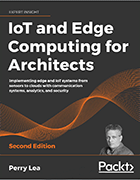Investigate IoT and edge computing nuances for architects
Author of 'IoT and Edge Computing for Architects' Perry Lea shares his expert advice on how to design interconnected architecture that addresses the challenges of both technologies.
IoT and edge computing go together like Sherlock and Dr. Watson: They are more successful when they work together, but they serve distinct roles to achieve desired results.
Despite how inherently interconnected IoT and edge computing are, the architect must lay the groundwork for the relationship to work. Each IoT and edge computing component affects the other. Architects must have a diverse set of skills because each design element changes how components fulfill their roles and their ability to scale and integrate.
Organizations have more than 1.5 million combinations of IoT and edge computing architectures to choose from, writes Perry Lea. In his book, IoT and Edge Computing for Architects, the Microsoft director of architecture explores IoT and edge computing basics, including the definitions, use cases and components; standards and protocols; and data analytics. Over the course of the book, readers follow the journey of IoT data to learn the intricacies of a well-designed IoT and edge architecture, starting with sensors and working through near- and long-range communication to migrate through the edge to the cloud.
Below is an excerpt from the IoT and edge computing book: Chapter 2, "IoT Architecture and Core IoT Modules." In a high-level overview, this chapter examines the various IoT and edge computing components, how they interconnect and the architect's approach to their role.
Particular areas of IoT and edge computing have challenged design teams and required detailed knowledge, such as future scalability. Architects must balance the value of different design choices based on why their organization or customer wants to use IoT. They must understand sensor physics, energy consumption, telecommunications, security challenges and cloud-based machine learning to meet the desired requirements.
Lea's book can prepare architects for the ideal design of IoT and edge computing architecture and it discusses successful real-world use cases for readers to learn more.
Click here to read Chapter 2 of IoT and Edge Computing for Architects.
 Click to learn more about the title.
Click to learn more about the title.




